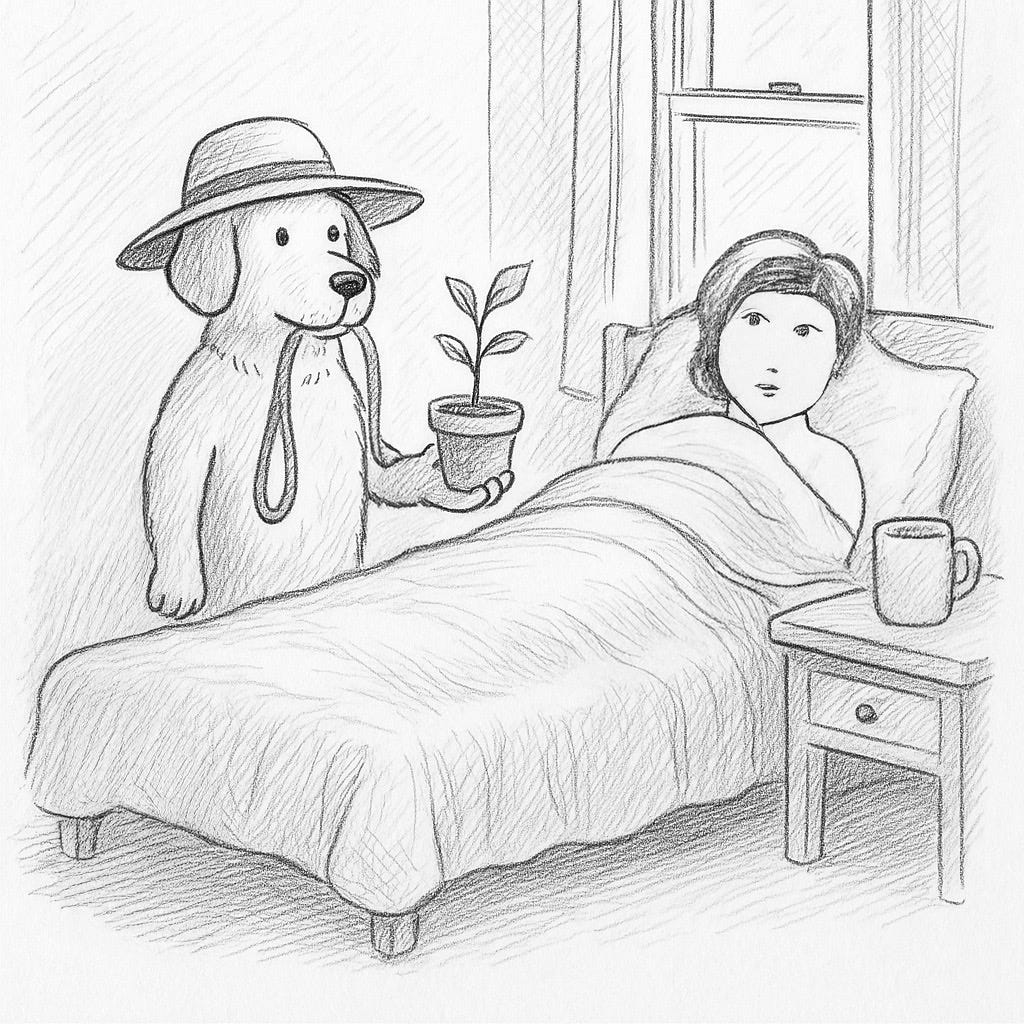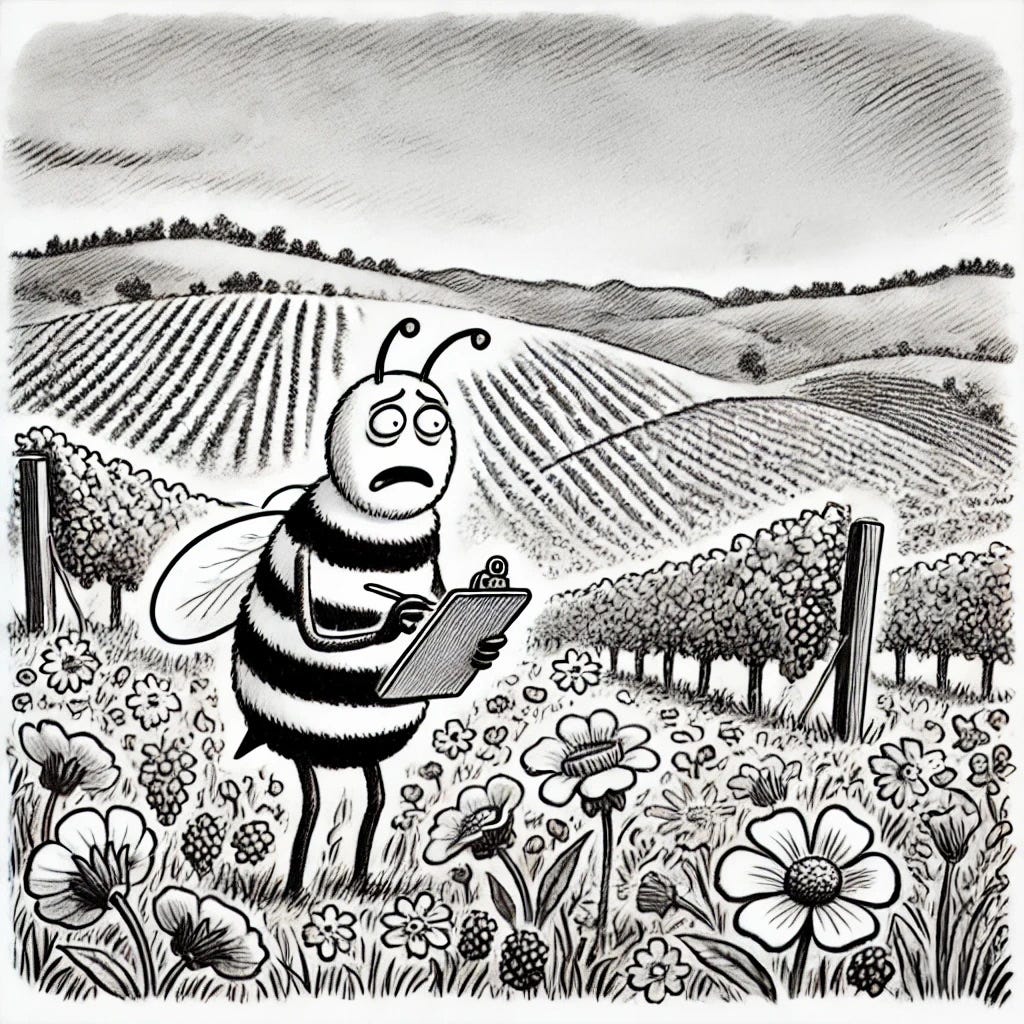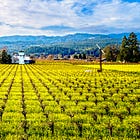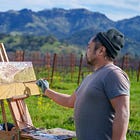Sunday E-dition: 15 Trees and Other Reasons to Get Out of Bed
By Sasha Paulsen
We Need Your Help
If you’re reading this, you care about independent, locally owned, ad-free journalism — reporting that puts our region’s stories first, not corporate interests or clickbait.
Join a community that values in-depth, independent reporting. Become a paid subscriber today — and if you already are, thank you. Help us grow by liking, commenting and sharing our work.
15 Trees and Other Reasons to Get Out of Bed
Editorial by Sasha Paulsen
NAPA VALLEY, Calif. — In my first year at UC Berkeley, owing to my imperfect understanding of how to enroll in a class, I landed not in freshman English but Survey of Russian Literature. It was not bad. In nine weeks we read nine novels that I might not otherwise have discovered. The one that has stayed with me all these intervening years is “Oblomov” by Ivan Goncharov. Published in 1859, it is the story of Ilya Ilyich Oblomov, a member of the Russian landed gentry who increasingly finds the world is too much for him and increasingly prefers to stay in his bed. His condition of apathetic helpless lethargy became known as “Oblomovism” or “Oblomovitis.”
I find myself thinking of Oblomov a lot these days as distressed friends and colleagues wonder aloud if they might be able to sleep through the next four years, knowing, of course, that however great the temptation, they cannot.
I began a list of strategies to help me want to get out of bed in the morning. I came up with:
1. Adopt a dog
2. Plant things
These are holdovers from 2016 to 2020, but they worked then to encourage a sense of hope. My daughter and I found Puck at the Napa animal shelter in November 2016, and he became a wonderful provider of joy and exercise, exuding a dog’s sense that while it may be a challenge to make humans understand what is important — walks, snacks, sniffing — life is a grand adventure.
As for planting, it’s what I did whenever the antics of humans with power brought to mind the late San Francisco Chronicle writer Art Hoppe and his columns in which St. Peter would ask the Celestial Landlord if it was not finally time to sound the eviction notice on that little blue-green planet of which He was so inexplicably fond. I had three trees in my backyard in 2016 and by 2020 I had nine, along with 10 new rosebushes and 32 lavender plants.
I didn’t add “write stories” to my list because, in truth, you can write while cowering in bed but also because each passing day I was finding it a challenge to write either fiction or nonfiction. Fiction was difficult because it is hard to imagine a world more fantastic than the one we are actually living in. And as nonfiction, what does one say?
But, back to steps one and two. I went to the Napa animal shelter and came home with Luz, a 6-year-old Siberian Husky with pronounced opinions on reasons to get up — to go for walks! To feed the dog! To go to the dog park and run like mad! To go visit Paul Franson and see what he is cooking! To savor life and whatever morsels an unthinking person accidentally leaves on the kitchen counter! To experience boundless joy! (She only ate one-fourth of a chocolate babka before I found her in the yard with it.)
I also sent a donation the Arbor Day Foundation, who promised they would either send me 15 trees or plant 100 trees somewhere that needed trees for me.
These helped, but I also did a third thing, which I had not done before: I signed up to be a substitute teacher in Napa schools because my friend, retired teacher and writer Rosie Kempton, told me there was a dire need for subs. I thought if I was never able to write again, at least I might earn an income this way.
Possibly as a result of all my exercise with Luz, I found the brain fog of despair caused by reading news — not a good thing for a journalist — was beginning to abate, and when I wasn’t frolicking at the dog park, I was making progress again on my novel. I still was not up to writing news, however.
I had not actually accepted a job subbing, largely because they call at 6 a.m. to see if you would like to dash off and teach middle school or kindergarten at 8, and at 6 a.m. this never seems like a good idea, Oblomovitis being what it is. But last week, as worried notices calling for teachers were piling up in my inbox, I said I would go to fill in at an elementary school, starting in 20 minutes. I never figured out if it was a grade two and three combination class or a grade three and four combo; I didn’t have time. I was too busying determining if it was really true that they had recess every 15 minutes and figuring out how to get one kid’s gooey dinosaur off the ceiling. (“I don’t know what happened. I was just sitting here holding it and the next thing, there it was.”)
Children possess a curiosity matched only, perhaps, by dogs, and so my earnest attempt to do a lesson on prefixes and suffixes turned into a conversation about why I think words are important. I was, I admitted to them, not a teacher but a writer. What had I written, they wanted to know.
“Two novels,” I began. “One is called ‘Dancing on the Spider’s Web’—”
“I read it!” one student exclaimed.
“Have you even written about someone famous like Stephen Curry?” another wanted to know.
I said no, but I had helped a man who was famous in our valley write his life story. They wanted to hear about the life and times of the Miljenko “Mike” Grgich, who had escaped from Communist Yugoslavia with American dollars hidden in his shoe and a dream to find his way to California and be a winemaker. They wanted to hear what it was like for Mike to live through World War II in his occupied village. “I am from Ukraine,” one boy volunteered. “So I know what he went through.”
They wanted to follow on a world map the route Mike took by ship and train and bus to get to Napa Valley. They especially liked the story of how Mike, alone and hungry, unable to speak English and afraid to spend his precious dollars, found a friend on the train who shared her basket of fried chicken with him. And there was the happy ending, when Mike made a wine so good it helped make our little valley famous.
Before I knew it, the day was over, and although I had not made a lot of progress on the lesson plans, owing to the number of recesses we took, I left with a sense of delight and hope, not to mention profound admiration for the people who do this work every day.
Back home, I would have retreated to my bed to sleep for a few days but for two things: It was time to go for a walk, Luz said. Also, a parcel was on my doorstep. “Thank you for your contribution to the Arbor Day Foundation,” a note read. “As a thank-you gift, we are sending you these 15 trees.” I apparently had checked the wrong box.
But I realized, as we trotted at a husky pace around the neighborhood, this is why we have to get out of bed: to save what is good about this world and make what is good better. It’s for the trees, it’s for dogs and it’s for the kids. It’s for all of us.
And now I have to go figure out where to plant 15 more trees.
—
Sasha Paulsen is a Napa Valley-based novelist and journalist.
Poem of the Day
A Calendar of Sonnets: March
Month which the warring ancients strangely styled
The month of war,—as if in their fierce ways
Were any month of peace!—in thy rough days
I find no war in Nature, though the wild
Winds clash and clang, and broken boughs are piled
As feet of writhing trees. The violets raise
Their heads without affright, without amaze,
And sleep through all the din, as sleeps a child.
And he who watches well may well discern
Sweet expectation in each living thing.
Like pregnant mother the sweet earth doth yearn;
In secret joy makes ready for the spring;
And hidden, sacred, in her breast doth bear
Annunciation lilies for the year.
About the Author: Helen Hunt Jackson (1830–85) was an American poet, novelist and activist whose work blended lyrical reflections on nature with fierce advocacy for social justice. Born in Amherst, Massachusetts, she was a classmate and lifelong correspondent of Emily Dickinson. After enduring the deaths of her husband and children, Jackson turned to writing as both solace and purpose. She became a prominent literary voice of her time, contributing to publications such as The Atlantic Monthly and Century Magazine.
Beyond poetry, Jackson was a tireless defender of Native American rights. Her nonfiction work “A Century of Dishonor” (1881) and her best-selling novel Ramona (1884) criticized U.S. policy and urged reform, earning her a place among the earliest voices for Indigenous justice in American literature.
Her “Calendar of Sonnets” (1891), published posthumously, captures the quiet power of seasonal change — blending observation, renewal and resilience. Her work remains rooted in the belief that attention to nature and empathy for others can be forms of resistance.
Are you a poet, or do you have a favorite piece of verse you'd like to share? Napa Valley Features invites you to submit your poems for consideration in this series. Email your submissions to napavalleyfeatures@gmail.com with the subject line: "Poem of the Day Submission." Selected poets will receive a one-year paid subscription to Napa Valley Features (a $60 value). We can’t wait to hear from you.
Caption Contest
Pick your favorite caption or add your own in the comments below.
Possible Captions:
“If you get up now, we can beat the squirrels.”
“I scheduled your existential crisis for later. Right now, we plant.”
“You said you wanted purpose. I brought two.”
“Don’t make me bark in metaphor.”
“Hope is weird like that. You have to participate.”
Last week’s contest results
In “Sunday E-dition: Napa Valley in Bloom,” the winning caption was, “The queen says to bring back something special… no pressure,” with 67% of the votes.
“The queen says to bring back something special… no pressure.”
“It’s tough to be influencer nowadays.”
“I might need a sommelier.”
“I need a tasting menu.”
“Which one of you have single-origin nectar?”
Last Week
Tim Carl analyzed Napa County’s January employment data in “What January’s Job Numbers Signal for Napa’s Future,” highlighting a disconnect between job growth and the region’s hospitality-driven economy. While agricultural employment temporarily boosted overall numbers, key sectors such as food service, hospitality and retail all declined, continuing a post-2019 stagnation. Carl argued that the region faces a demand-side crisis, not a supply shortage, as new hotels and wineries open despite falling visitor numbers and flat employment. Broader global pressures, including declining international tourism and economic shifts, have exacerbated the slowdown. He warned that without strategic change, Napa risks deeper economic contraction.
Kathleen Scavone examined the geological significance of serpentine rock in her article “Serpentine Our State Rock Abounds in Napa County.” She explained how the mineral-rich, nutrient-poor serpentine soils support rare and specialized plant communities, particularly in places like the McLaughlin Natural Reserve. The article highlighted serpentine's connection to NASA research as scientists study its properties as analogs to potential Martian environments. Scavone also discussed the unique wildlife and biodiversity supported by serpentine outcrops throughout the region. The piece underscored Napa County’s geological complexity and ecological richness.
Kailee Musgrove and Charlotte Hajer explored the mental health challenges facing adolescents in their article “More Than a Phase: Supporting Teens Through Real Struggles.” The piece highlighted how identity formation, emotional volatility and social pressures contribute to heightened vulnerability during adolescence, especially for marginalized youth. Musgrove emphasized the need for supportive adult relationships and accessible mental health resources, noting the increased risks faced by LGBTQIA+ and BIPOC teens. The authors called for empathy, consistency and radical acceptance from caregivers and communities to foster resilience in young people.
Jane Callier offered guidance on preparing spring vegetable gardens in her article “When and How to Plant Your Spring Tomatoes.” She explained the differences between heirloom, open-pollinated and hybrid tomato varieties, emphasizing how each reproduces and performs in home gardens. Callier also shared best practices for planting, including timing, sunlight needs and crop rotation to prevent disease. For those with limited space, she recommended disease-resistant hybrids like Celebrity Plus. The article also highlighted several tomato varieties available at the upcoming UC Master Gardener tomato plant sale.
Tim Carl profiled Grgich Hills Estate’s regenerative farming approach in “Grgich Hills — Custodians of a Sacred Place.” Led by Ivo Jeramaz and Violet Grgich, the winery has moved beyond organic and sustainable practices to prioritize soil health, microbial diversity and long-term vineyard resilience. Jeramaz emphasized that regenerative farming reduces inputs, strengthens vines and improves wine quality by fostering living soil systems and integrating livestock. Amid rising climate pressures and economic challenges, he argued that resilience begins underground. The article connected ecological practices to Grgich Hills’ commitment to legacy, land stewardship and honest winemaking.
Kathleen Scavone celebrated the region’s vibrant wildflower season in “Sunday E-dition: Napa Valley in Bloom.” She highlighted the abundance of native blooms such as milkmaids, miner’s lettuce, Dutchman’s pipe and checker lilies appearing across parks, roadsides and valleys, with guided hikes offered by local groups such as the California Native Plant Society. Scavone also reflected on historical and cultural connections to wildflowers, including Indigenous uses of miner’s lettuce and California hazelnuts. The article noted an exhibition of 19th-century botanical watercolors by Sophie Alstrom Mitchell at the Napa Valley Museum. Napa’s spring bloom, Scavone wrote, is both a natural spectacle and a living heritage.
—
Explore These Related Articles:
Browse All Napa Valley Features Stories
The views, opinions and data presented in this article are those of the author and do not necessarily reflect the official policy, position or perspective of Napa Valley Features or its editorial team. Any content provided by our authors is their own and is not intended to malign any group, organization, company or individual.
















Henry Wadsworth Longfellow: The Rainy Day
The day is cold, and dark, and dreary;
It rains, and the wind is never weary;
The vine still clings to the moldering wall,
But at every gust some dead leaves fall,
And the day is dark and dreary
My life is cold, and dark, and dreary;
It rains, and the wind is never weary;
My thoughts still cling to the moldering Past,
But the hopes of youth fall thick in the blast,
and the days are dark and dreary
Be still, sad heart! and cease repining:
Behind the clouds is the sun still whining;
Thy fate is the common fate of all,
Into each life some rain must fall,
Some days must be dark and dreary.
Sasha: Loved your article. My mother's favorite rainy day poem...always repeated on rainy days!
Once again, Sasha, you open up the depths of the world around us through stories of seemingly innocent intimacies, reminiscent of William Blake's famous poem, Auguries of Innocence:
To see a world in a grain of sand
And a heaven in a wild flower,
Hold infinity in the palm of your hand
And eternity in an hour.
Thank you for another great read.